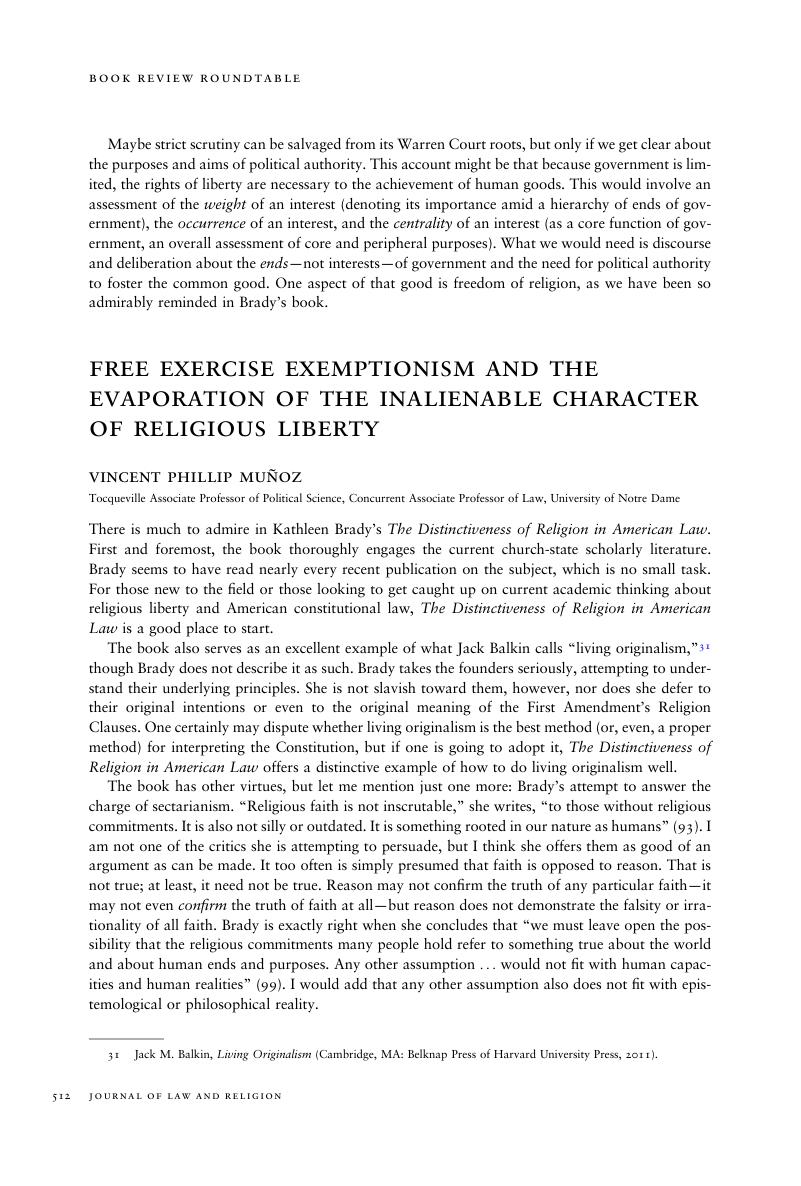No CrossRef data available.
Article contents
FREE EXERCISE EXEMPTIONISM AND THE EVAPORATION OF THE INALIENABLE CHARACTER OF RELIGIOUS LIBERTY - The Distinctiveness of Religion in American Law: Rethinking Religion Clause Jurisprudence. By Kathleen A. Brady. Cambridge: Cambridge University Press, 2015. Pp. 354. $39.99 (paper). ISBN: 978-1107016507.
Published online by Cambridge University Press: 12 April 2018
Abstract

- Type
- Book Review Roundtable
- Information
- Copyright
- Copyright © Center for the Study of Law and Religion at Emory University 2018
References
31 Balkin, Jack M., Living Originalism (Cambridge, MA: Belknap Press of Harvard University Press, 2011)CrossRefGoogle Scholar.
32 McConnell, Michael W., “The Origins and Historical Understanding of Free Exercise of Religion,” Harvard Law Review 103, no. 7 (1990): 1409–1517CrossRefGoogle Scholar; McConnell, Michael W., “Free Exercise Revisionism and the Smith Decision,” University of Chicago Law Review 57, no. 4 (1990): 1109–53CrossRefGoogle Scholar.
33 See Muñoz, Vincent Phillip, “The Original Meaning of the Free Exercise Clause: The Evidence from the First Congress,” Harvard Journal of Law and Public Policy 31, no. 3 (2008): 1083–1120Google Scholar; Hamburger, Philip, “A Constitutional Right of Religious Exemption: An Historical Perspective,” George Washington Law Review 60, no. 4 (1992): 915–48Google Scholar; Bradley, “Beguiled.”
34 For further discussion of this point, see Muñoz, Vincent Phillip, “Church and State in the Founding-Era State Constitutions,” American Political Thought 4, no. 1 (2015): 1–38CrossRefGoogle Scholar. See also Muñoz, “The Original Meaning of the Free Exercise Clause.”
35 Muñoz, Vincent Phillip, “If Religious Liberty Does Not Mean Exemptions, What Might It Mean? The Founders' Constitutionalism of the Inalienable Rights of Religious Liberty,” Notre Dame Law Review 91, no. 4 (2016): 1387–417Google Scholar.
36 Kurland, Philip B. and Lerner, Ralph, The Founders' Constitution, reprint ed. (Chicago: University of Chicago Press, 2000)Google Scholar. The full text is now available online at http://press-pubs.uchicago.edu/founders/. For the Delaware Declaration of Rights and Fundamental Rules (1776), see Amendment I (Religion), Document 26. For the Pennsylvania Constitution of 1776, see Amendment I (Religion), Document 30. For the Vermont Constitution of 1777, see Amendment I (Religion), Document 35. In the print version of the The Founders' Constitution, Amendment I is located in Volume 5.
37 Muñoz, Vincent Phillip, “Two Concepts of Religious Liberty: The Natural Rights and Moral Autonomy Approaches to the Free Exercise of Religion,” American Political Science Review 110, no. 2, (2016): 369–81CrossRefGoogle Scholar, at 373.




